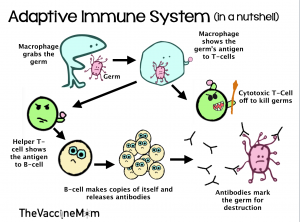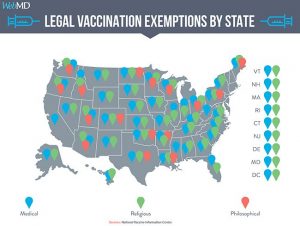What’s with the H’s and the N’s? What’s a flu strain?
Every year there’s a new flu shot. What’s going on with all these different “strains,” and what does it all mean?
There are four different types of influenza: A, B, C, and D. Influenza D is found in cattle and influenza C causes a mild respiratory infection. That leaves A and B. Both A and B types are included in the flu shot every year. In the quadrivalent shot (four viruses) there are two A and two B strains. In the trivalent shot (three viruses) there are two A’s and one B.
The B type influenza isn’t divided into subtypes, but the A influenza type is. When you hear about type A, you often hear it associated with two letters: H and N. The seasonal flu vaccine has two subtypes of influenza A: H1N1 and H3N2. These are the two most common subtypes that infect humans.
The H stands for hemagglutinin (HA) and the N stands for neuraminidase (NA). These are two proteins on the surface of the flu virus. There are 18 different HA proteins and 11 different N proteins, so you can imagine all the possibilities of combinations of H’s and N’s you can have.
Not many viruses look like the ball-and-stick virus you often see pictured (like the emoji on your phone). The flu, however, does. That’s because of the HA and NA proteins on its surface. My daughter loves drawing this virus, as you can see from the photo!
The problem with the flu virus is that it can easily mutate. The mutations in the H’s and N’s are what we call “strains”. The strains that circulate are what scientists try to predict for the flu vaccine each year. For example, one of the influenza A strains, the H1N1 strain, in the vaccine this year is the H1N1 A/Brisbane/02/2018-like virus.
Scientists take into consideration the strains circulating in the Southern Hemisphere over their last winter, as well as what circulated in the Northern Hemisphere over our previous winter when deciding on this year’s flu vaccine strains.
That’s why you need a new flu vaccine every year.
You may argue that the scientists sometimes guess the circulating strains wrong and that the flu shot is pointless. Although the circulating strains aren’t always spot-on, because they tend to be similar to what’s circulating, the flu vaccine will still offer at least some protection. Even if you get the flu and have had the vaccine, there’s a good chance that the vaccine has helped shorten the amount of time you were sick, as well as how bad you were sick.
There’s no reason not even to give yourself some protection if you can.
We have other forms of influenza A that don’t cause large outbreaks and are not in the annual flu vaccine.
There are times when an animal flu, such as the swine or avian flu, jumps into the human population. This type of flu, although not easily spread from person to person, is particularly deadly in those infected. For example, the avian flu (H5N1) in 1997 killed around 60% of those infected.
The goal is a universal flu vaccine–one that offers protection for all A and B types. It may be on the horizon. For now, do your best to protect yourself, your family, and your community by getting vaccinated.


